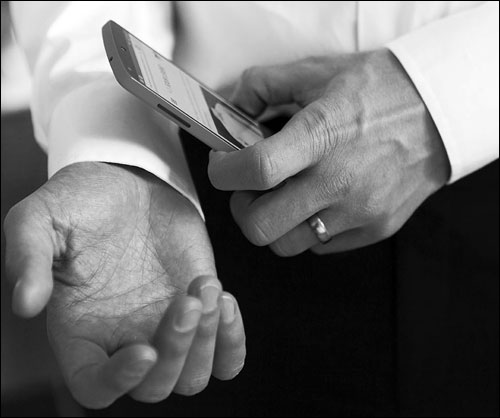Four Levent, a Swedish men’s clothing startup, has begun marketing what it calls wearable technology, consisting of a shirt with a Near Field Communication (NFC) RFID tag embedded in each cuff. The tags are intended to transmit data—such as information about the shirt itself, or the wearer’s contact information, company URL or full business card—to an NFC-enabled mobile phone. The company offers four versions of the dress shirt for sale at its website, says Hans Gunnarsson, one of Four Levent’s cofounders, and customers in Europe and the United States have purchased the garments since their release in May 2014.
Four Levent is a spinoff of management company The Synthetic Family, operated by Gunnarsson and his two brothers. That firm provides project- and change-management consultant services to such businesses as Skanska and the Swedish Armed Forces. According to Gunnarsson, the brothers recently launched a very different product offering through Four Levent (named after the district in Istanbul, Turkey, where they lived for several years as children), after considering ways to make the conducting of business more interesting through technology. He recalls sitting in management meetings musing about how plain business shirts could be made more interesting. The Four Levent men’s dress shirt was the result.
“There are two things that make our shirts more interesting,” Gunnarsson explains: the design of the shirt itself (with a distinct stripe on the collar or other part of the garment, and the use of high-quality fabric), as well as something no other shirt currently offers—an NFC tag sewn into each sleeve cuff.
At present, businessmen who wish to share their personal data automatically via NFC can carry an NFC tag embedded in a business card, or use their smartphone. There are shortcomings with both options, Gunnarsson reports, since a business card would still need to be taken from a pocket or bag and be presented to an individual, while a phone would require a downloaded app to enable the transfer of data between two phones via NFC.
Four Levent’s solution would be fairly simply, Gunnarsson says. An RFID tag made with NXP Semiconductors‘ NTAG203 RFID chip is sewn into each cuff. The chip has enough memory (a total of 168 bytes) to store a unique ID number, as well as some basic information, such as would be printed on a business card.
When a person taps a smartphone against the cuff’s tag, the phone automatically accesses Four Levent’s website (no app is required for the phone user), thereby providing the user with details regarding the shirt. Therefore, if someone compliments a Four Levent shirt that a man is wearing, he can simply reply, “Tap your phone here,” and the other person can learn how to buy the shirt, and obtain details about it. If that individual then makes a purchase after reading the NFC tag of that garment, the man wearing it man will earn a $45 discount off the $230 purchase price for an additional shirt.
However, Gunnarsson notes, the greater value for the shirt owner is in the ability to write additional data to the tag. To do this, the owner would need to download a free app—for example, the NFC TagWriter by NXP app for Android phones, or the Nokia NFC Writer app for Microsoft Windows phones. The app would then enable him to write data to the tag. To do so, he would tap the phone against the tag, then follow instructions to write information, such as his company name, URL or e-mail address. Gunnarsson, who wears his own products, says he has written data including his website’s URL to one cuff’s tag, and his other business-card information to the other cuff.
However, Gunnarsson says, the tag can be used for other functions as well. For example, some customers have programmed the tag to put their mobile phone into and out of silent mode as they enter or leave a business meeting.

Another of Four Levent’s clients is interested in using the shirt for access control. For example, that firm could set up an NFC-enabled lock at its office’s entrance, and provide the shirts to its employees. When an employee taps his sleeve cuff against the NFC reader built into the lock, the door would automatically unlock if the NFC tag was authenticated. Gunnarsson notes that California NFC-enabled lock technology firm Lockitron manufactures the kind of technology that would work with the tags.
To ensure that the NFC tag would last for the duration of the shirt’s lifetime, Four Levent put it through testing that included laundering and tumble-drying, under conditions that he says “would ruin the shirt” before they appeared to damage the tag. The company also tested the tag to ensure it would not create problems with airport screening technology.
According to Gunnarsson, since the shirts’ release last month, the company has sold them primarily in Sweden, but also in the United States, Portugal, Poland and Belgium. He says customers are still suggesting use cases for the tag, adding, “It’s really intended to be fun—it makes doing business more interesting.”


